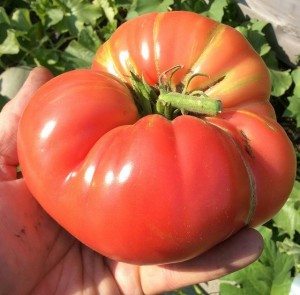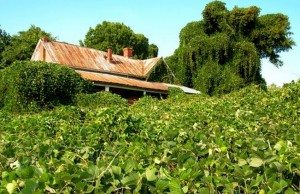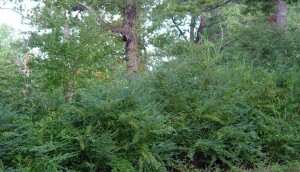 This “ugly” heirloom Brandywine would most likely never make it to a store. In addition to being irregular in shape, it has major creasing on the underside.
This “ugly” heirloom Brandywine would most likely never make it to a store. In addition to being irregular in shape, it has major creasing on the underside.
If we are lucky it would make it to a food pantry or the ketchup factory. But it just as likely would be composted or sent to the landfill.
Of course when you cut into it and taste it, you get to experience amazing flavor. You really can’t compare a garden tomato to one of those red tomatoes from the store.
It’s not just how we grow and distribute our food that is a problem but also how we as consumers affect the market.#FoodMatters
TCMG’ regular monthly meeting will be TUESDAY, SEPTEMBER 8 at 5:30 pm in the auditorium of The Tuscaloosa County Extension Service Building.

Our CEU speaker will be Judith Rives, herb specialist, who will present “New Tricks with Herbs”. The public is welcome to attend.
Looking forward to seeing you Tuesday, September 8 @ 5:30. Have a FUN WEEK ahead, including the long Labor Day weekend that follows!!!

Invasive plant species are an increasing issue across the country–pushing out native flora and changing ecosystems. Dr. Nancy Loewenstein, an Alabama Extension invasive plant specialist a, says invasive plant species’ should be taken seriously and can be battled with the proper information and techniques.
“An invasive species is one that has become weedy and is displacing native plant species and changing the way ecosystems function,” Loewenstein said. “For example, some burn more easily, or hotter, while others prevent fires in areas that need to burn and some change wildlife habitats.”
An invasive plant is a non-native species that has been introduced to an area by mankind that causes, or is likely to cause, environmental or economic harm.
 In Alabama, the most commonly seen invasive plant species include kudzu, Japanese honeysuckle, Chinese tallowtree and Chinese privet. These species were introduced to the area as ornamental plants that then escaped cultivation into the wild.
In Alabama, the most commonly seen invasive plant species include kudzu, Japanese honeysuckle, Chinese tallowtree and Chinese privet. These species were introduced to the area as ornamental plants that then escaped cultivation into the wild.
“Many of the invasive species in Alabama are escaped ornamentals,” said Loewenstein, who is an Auburn University School of Forestry and Wildlife Sciences research fellow. “They produce a lot of seeds and take up a lot of room, crowding and outcompeting native plants.”
This competition with native plant species presents a danger to animals that live in invaded areas. Next to habitat loss, invasive plants have one of the largest impacts on endangered species and biodiversity. This impact also comes from a lack of contribution to the food chain.
“Non-native plants don’t have insects on them like native plants do,” Loewenstein said. “In a lot of ways, they are biological deserts.”
For these reasons, it is important to understand the difference between native and non-native plant species and to know how to respond to them.
“Many invasive plant species are spread by birds, so if you find that you are harboring a species, such as Chinese tallowtree, with seeds that are being eaten by a lot of birds, you might consider removing it from your yard,” Loewenstein added.
Removal methods for invasive plants depend on the different kinds of species. When cut down, most invasive plants will grow right back. In order to target the root of the species, careful and selective use of herbicides work best.
“The earlier you catch something, the better,” Loewenstein said. “The longer you wait, the more time and money it’s going to take to remove the infestation.”
Although there are removal options for invasive plants species, the best way to stop the spread of invasive species is to avoid planting them altogether.
“What we plant in our yard has an impact beyond our yard,” Loewenstein said. “Think about what you’re planting… think about the impact.”
Learn more about invasive plants and their impact at Alabama Extension’s Invasive Species website.
I’m a B, I think…sometimes I get very lucky and create something beautiful. What are you? Leave a reply!

 Menu
Menu Search
Search




